
GINZA CONNECTIVE
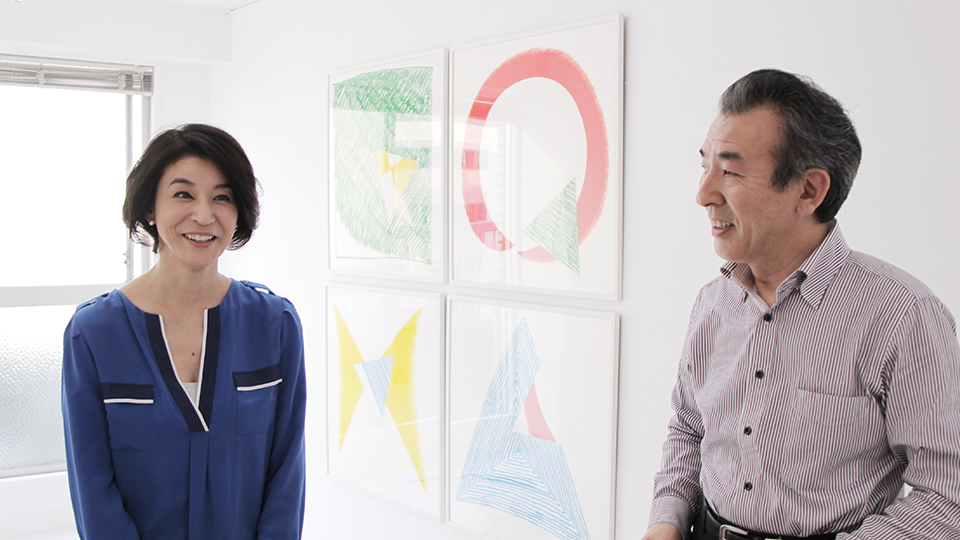
GINZA CONNECTIVE VOL.19
Hozu Yamamoto×Chisako Takashima
2013.04.01
A talk series with the violinist Chisako Takashima and the Ginza people. Ginza holds many personal and professional memories for Takashima. In this talk series, she thoroughly explores various aspects of the Ginza culture with her guests. Today’s guest is Hozu Yamamoto, president of Tokyo Gallery, Japan’s first modern art gallery.
The more negative an art piece is, the more strongly it can shift into a positive light.
- Yamamoto
- I feel that the more negative an art piece is, the more strongly it can shift into a positive light.
- Takashima
- How is that so?
- Yamamoto
- Take Disneyland’s Mickey Mouse. It’s a mouse, right? Mice are despised pests that carried diseases throughout Europe. So, I thought it odd that Walt Disney would choose a mouse as his main character.
Well, apparently, his first character was a rabbit. Then, he was deceived by someone and the rights for his rabbit were taken from him, so he couldn’t use it anymore. He thought about what animal he could use that nobody would take from him, and decided on a mouse. - Takashima
- Is that so! I never knew that.
- Yamamoto
- Mice are perceived negatively as being despised by people, and thus have a strong ability to turn positive. It’s the same with art. I think that the more absurd it is, the more power it has to turn positive. What I often tell young artists is that they should not fill one piece entirely with brightness. It should also make you feel a sense of darkness. If you don’t put death, which is what humans hate the most, into a work of art, it won’t endure. Humans do not exist solely in brightness. It is the existence of darkness that makes brightness shine more strongly. That is why I think we quickly tire of art pieces that are only bright and soothing.
- Takashima
- So, when you choose works of art, you base your selection on whether it has strong negative power in addition to positive power?
- Yamamoto
- Yes, exactly. First off, I listen to the artist’s story and try to ascertain how much that person needs art. I only choose artists who would be desolate without art.
- Takashima
- That’s very extreme (laughs).
- Yamamoto
- Yes, because it’s a problem if they lose interest in 5 or 10 years. Those that are just ordinarily intelligent are also no good. Because they’re clever, they tend to change directions to something different. The good ones are those that completely devote themselves to art at all times.
- Takashima
- To completely devote yourself to art — sounds like a happy life.
- Yamamoto
- Sure. That’s why they can put up with being poor. Even van Gogh only sold two paintings during his lifetime. He would never have guessed that one day his paintings would sell for millions of dollars.
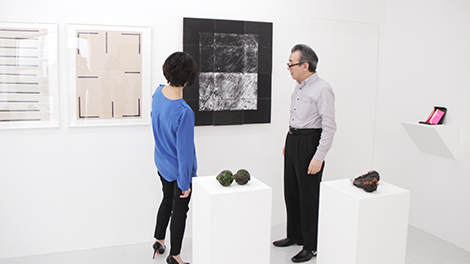
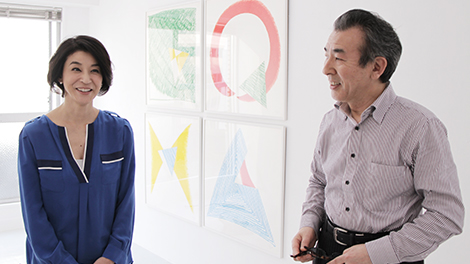
Ginza should combine a global standard and locality.
- Takashima
- I think art plays an important role in revitalization. Is anything like this being tried in Ginza?
- Yamamoto
- For 8 years, Ginza held a competition called the Space Design Competition. In this competition students were given free range of the show windows of 10 shops, including Shiseido and Mikimoto and could design the display. Unfortunately the competition is finished, but our next plan is a project based on photography.
- Takashima
- That sounds fun. How would you like Ginza to be in the future?
- Yamamoto
- I think it is important to combine a global standard and locality. Back when there was no global standard, it was okay to live in an area without knowing its characteristics. This is what is known as being noncosmopolitan. But the noncosmopolitan era has ended. Now we have to reconsider locality.
- Takashima
- What do you mean by locality?
- Yamamoto
- Locality is when outsiders come in to your community and things you never noticed before that seemed perfectly natural suddenly become extremely interesting. By seeing things through another person’s eyes, you create a definition of what you are. If we don’t maintain locality in Ginza, it will become just another district with shops similar to some other district. I think it would be great if Ginza maintains a global standard on the main streets as well as locality on the off streets.
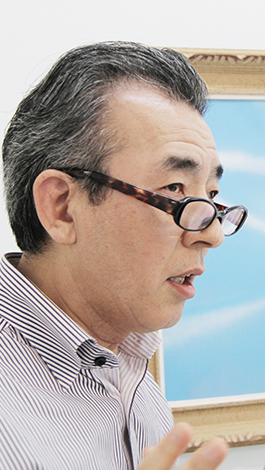
The next guest will be…
- Takashima
- Could you tell us about the next guest?
- Yamamoto
- It’s Koji Shibata, president of Ginza-Kanameya, a kimono accessories store. His shop has a particularly large collection of tortoiseshell ornamental hairpins, some of which are truly works of art. It is definitely worth seeing.
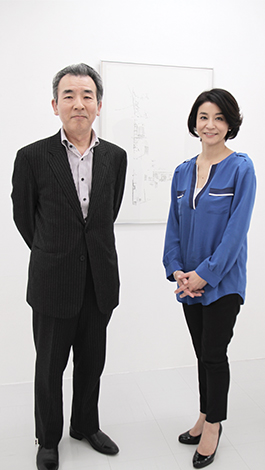
Chisako Takashima
Violinist. Started playing the violin at age 6. After playing abroad, she moved her home base to Japan, and gives concerts all over the country. Although her current focus is on performing music, she also appears on TV and radio programs. Thanks to her much-loved personality, she is appearing in more and more venues.
Chisako Takashima’s official websiteHozu Yamamoto
Born in 1948. President of the Tokyo Gallery. Graduated from the Musashino Art University in 1971, and took on his current position after 7 years as a secretary for a member of the Diet. He was one of the first to introduce leading modern artists from the West to Japan, and began also focusing on modern art from South Korea in the 70’s and from China in the latter half of the 80’s. In 2002, he opened B.T.A.P (pronounced “B-tap”) in the Dashanzi Art District of Beijing. He is also dedicated to the development of Ginza.
Website of Tokyo GalleryWriter: Mikiko Okai Interview location: Tokyo Gallery
1 2
All List
- GINZA CONNECTIVE VOL.0 Ryo Sayegusa×Chisako Takashima
- GINZA CONNECTIVE VOL.1 Toshiyuki Kosaka×Chisako Takashima
- GINZA CONNECTIVE VOL.2 Yasuharu Mizuhara×Chisako Takashima
- GINZA CONNECTIVE VOL.3 Hitoshi Ishihara×Chisako Takashima
- GINZA CONNECTIVE VOL.4 Shinji Hara×Chisako Takashima
- GINZA CONNECTIVE VOL.5 Choichiro Motoyama×Chisako Takashima
- GINZA CONNECTIVE VOL.6 Noriko Okazoe×Chisako Takashima
- GINZA CONNECTIVE VOL.7 Choichiro Motoyama×Chisako Takashima
- GINZA CONNECTIVE VOL.8 Sayuri Yamaguchi×Chisako Takashima
- GINZA CONNECTIVE VOL.9 Yoshiki Tani×Chisako Takashima
- GINZA CONNECTIVE VOL.10 Yoshifumi Itoh×Chisako Takashima
- GINZA CONNECTIVE VOL.11 Kunihiko Miwa×Chisako Takashima
- GINZA CONNECTIVE VOL.12 Shin Watanabe×Chisako Takashima
- GINZA CONNECTIVE VOL.13 Akihiko Tsuda×Chisako Takashima
- GINZA CONNECTIVE VOL.14 Rie Horikawa×Chisako Takashima
- GINZA CONNECTIVE VOL.15 Jun Takahashi×Chisako Takashima
- GINZA CONNECTIVE VOL.16 Yusuke Harada×Chisako Takashima
- GINZA CONNECTIVE VOL.17 Lintaro Mizuhara×Chisako Takashima
- GINZA CONNECTIVE VOL.18 Keisuke Anzai×Chisako Takashima
- GINZA CONNECTIVE VOL.19 Hozu Yamamoto×Chisako Takashima
- GINZA CONNECTIVE VOL.20 Koji Shibata×Chisako Takashima
- GINZA CONNECTIVE VOL.21 Kayo Hosono×Chisako Takashima
- GINZA CONNECTIVE VOL.22 Mitsuru Saito×Chisako Takashima
- GINZA CONNECTIVE VOL.23 Akihisa Kawaguchi×Chisako Takashima
- GINZA CONNECTIVE VOL.24 Mamoru Sugiyama×Chisako Takashima
- GINZA CONNECTIVE VOL.25 Michiaki Kumagai×Chisako Takashima
- GINZA CONNECTIVE VOL.26 Shinichi Tanizawa×Chisako Takashima
- GINZA CONNECTIVE VOL.27 Koichi Suzuki×Chisako Takashima
- GINZA CONNECTIVE VOL.28 Munehito Matsuzaki×Chisako Takashima
- GINZA CONNECTIVE VOL.29 Hiroshi Hara × Chisako Takashima
- GINZA CONNECTIVE VOL.30 Shigeyuki Ando×Chisako Takashima
- GINZA CONNECTIVE VOL.31 Yukichi Ishikura × Chisako Takashima
- GINZA CONNECTIVE VOL.32 Seiko Yamada × Chisako Takashima
- GINZA CONNECTIVE VOL.33 Mami Nagai × Chisako Takashima
- GINZA CONNECTIVE VOL.34 Ryuta Takahashi × Chisako Takashima
- GINZA CONNECTIVE VOL.35 Kazumasa Osumi×Chisako Takashima
- GINZA CONNECTIVE VOL.36 Masahiro Kameoka×Chisako Takashima
- GINZA CONNECTIVE VOL.37 Shoichiro Watanabe×Chisako Takashima
- GINZA CONNECTIVE VOL.38 Keiji Niimoto×Chisako Takashima
- GINZA CONNECTIVE VOL.39 Chieko Nakamura ×Chisako Takashima
- GINZA CONNECTIVE VOL.40 Atsushi Yamane×Chisako Takashima
- GINZA CONNECTIVE VOL.41 Masaya Shibuya×Chisako Takashima
- GINZA CONNECTIVE VOL.42 Makoto Suzuki×Chisako Takashima
- GINZA CONNECTIVE VOL.43 Masaya Konaka×Chisako Takashima
- GINZA CONNECTIVE VOL.44 Masakazu Tanaka×Chisako Takashima
- GINZA CONNECTIVE VOL.45 Koko Kameoka × Chisako Takashima
- GINZA CONNECTIVE VOL.46 Jin Hirayama×Chisako Takashima
- GINZA CONNECTIVE VOL.47 Takashi Hoshihara×Chisako Takashima
- GINZA CONNECTIVE VOL.48 Mikiko Kimura × Chisako Takashima
- GINZA CONNECTIVE VOL.49 Keisuke Okamoto×Chisako Takashima
- GINZA CONNECTIVE VOL.50 Akira Ito × Chisako Takashima
- GINZA CONNECTIVE VOL.51 Tatsuhiko Adachi × Chisako Takashima
- GINZA CONNECTIVE VOL.52 Masahiko Yamano×Chisako Takashima
- GINZA CONNECTIVE VOL.53 Kiyoshi Kanazashi×Chisako Takashima
- GINZA CONNECTIVE VOL.54 Noriyuki Tsuji×Chisako Takashima
- GINZA CONNECTIVE VOL.55 Shoichi Kobayashi×Chisako Takashima
- GINZA CONNECTIVE VOL.56 Isao Nanjo×Chisako Takashima
- GINZA CONNECTIVE VOL.57 Shinobu Mitsuoka×Chisako Takashima
- GINZA CONNECTIVE VOL.58 Motoyoshi Yasuda×Chisako Takashima
- GINZA CONNECTIVE VOL.59 Toru Fujiki×Chisako Takashima
- GINZA CONNECTIVE VOL.60 Yuji Ida×Chisako Takashima
- GINZA CONNECTIVE VOL.61 Hitoshi Miki×Chisako Takashima
- GINZA CONNECTIVE VOL.62 Takehiko Furuya× Chisako Takashima
- GINZA CONNECTIVE VOL.63 Naoki Yoshizawa×Yusuke Yoshizawa×Chisako Takashima
- GINZA CONNECTIVE VOL.64 Kazuhito Kawase × Chisako Takashima
- GINZA CONNECTIVE VOL.65 Toshiji Yuki× Chisako Takashima
- GINZA CONNECTIVE VOL.66 Hikoyuki Yamaguchi×Chisako Takashima
- GINZA CONNECTIVE VOL.67 Daisuke Nagano×Chisako Takashima
- GINZA CONNECTIVE VOL.68 Shuichi Motohashi× Chisako Takashima
- GINZA CONNECTIVE VOL.69 Shinpei Tonaka×Chisako Takashima
- GINZA CONNECTIVE VOL.70 Shinya Kanematsu × Sachiko Takashima
- GINZA CONNECTIVE VOL.71 Masataka Yano×Chisako Takashima
- GINZA CONNECTIVE VOL.72 Mitsuhiro Kurokawa× Chisako Takashima
- GINZA CONNECTIVE VOL.73 Ryo Saegusa×Chisako Takashima








